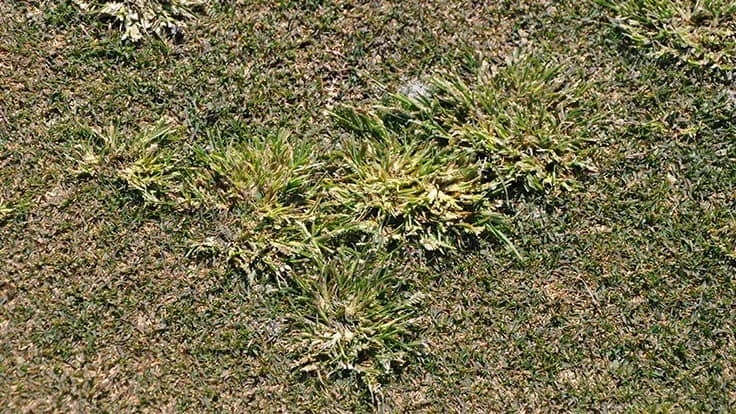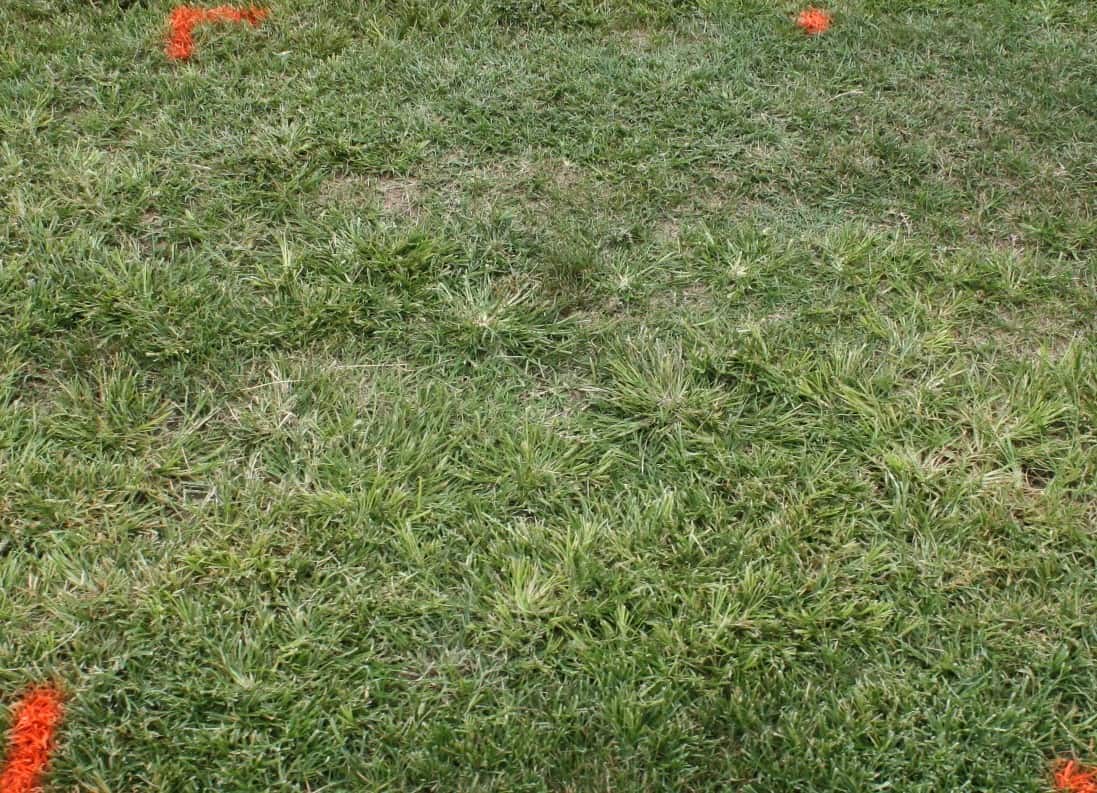
By Eric Reasor, Ph.D.
Goosegrass (Eleusine indica) is a grassy weed that has been troublesome in warmer climates and the Transition Zone. However, it has now made its presence known in more northern regions such as Kentucky, New Jersey and Pennsylvania.
Proper identification
Goosegrass is a summer annual that emerges in the spring and then produces seeds when the temperatures decrease in the fall. However, goosegrass is a weed that can perennate in southern climates such as south Florida and Hawaii. Goosegrass identification can often be confused with crabgrass (Digitaria spp.). Goosegrass leaves have a more rounded leaf tip, flattened stems and a white-colored plant base (Figure 1A). Finally, goosegrass has very distinct seed heads that easily distinguish it from other summer annual grassy weeds (Figure 1B). Correct identification is vital because most herbicide control options for goosegrass are different than for crabgrass.

Mature goosegrass plant with flattened stems and white base.
Goosegrass seed head.
Cultural control is the foundation
Goosegrass is not unlike all other turfgrass weeds in that a healthy, actively growing turfgrass stand is the foundation to a weed management program. This includes correct mowing, irrigation, fertilization and cultivation practices based on the desired turfgrass species. Goosegrass specifically prefers compacted soils. Therefore, aerification and traffic management are critical to begin controlling goosegrass. It also is very competitive against turfgrasses at lower mowing heights such as golf course fairways and greens (Figure 2) where it is typically more problematic than in roughs.
Goosegrass present in a Bermudagrass putting green.
Pre-emergent herbicides
Herbicide control is inevitable when managing goosegrass. Pre-emergent herbicides are the basis of an herbicide program for goosegrass. These products work by forming a “barrier” in the soil and when the weed seeds germinate. The weeds then absorb the herbicide and are controlled before they emerge above the soil surface.
To maximize pre-emergent control, herbicide active ingredient (AI) selection and application timing are critical. Products that contain the herbicide oxadiazon and indaziflam are extremely effective at controlling goosegrass. However, these cannot be applied to all turfgrass species, so read the product label carefully before application. Additional AIs used for pre-emergence goosegrass control include (but are not limited to) prodiamine, dithiopyr and pendimethalin.
Perhaps more important than AI selection is application timing. Goosegrass typically germinates three to six weeks later than crabgrass, so application strategies should be adjusted to match the germination period. “Split-PRE” herbicide applications often yield maximum goosegrass control.
In this strategy, a pre-emergent herbicide is applied for crabgrass control, and then another application is made four to six weeks later. This increases the length of time the herbicide “barrier” is in the soil and able to control goosegrass. Furthermore, applying oxadiazon or indaziflam at the second application timing can increase pre-emergent goosegrass control. Pre-emergent herbicide programs are effective at controlling goosegrass if AI selection and timing are considered.
Post-emergent herbicides
Post-emergent herbicides are needed for goosegrass control when pre-emergent herbicides do not provide acceptable control. The strategies for post-emergence goosegrass control are similar to pre-emergence with respect to AI selection and application timing.
Herbicide selection for post-emergence control depends on the desired turfgrass species, turfgrass use (i.e., putting greens or fairways) and tolerable injury levels. In cool-season turfgrass, topramezone, fenoxaprop, and the combination of 2,4-D+dicamba+MCPP+carfentrazone can provide adequate control.
In warm-season turfgrasses, foramsulfuron, metribuzin, topramezone, the combination of foramsulfuron+halosulfuron+thiencarbazone, and the combination of 2,4-D+dicamba+MCPP+carfentrazone can be applied for post-emergence control. However, there are limitations with these, such as turfgrass injury, application on putting greens and goosegrass plant maturity. Young, immature goosegrass plants are much easier to control than large, mature plants. Lower herbicide rates and fewer applications are required for acceptable control if herbicides are applied at the proper timing.
Rotation, Rotation, Rotation
Herbicide selection for goosegrass control is somewhat limited and is continuing to become more limited with herbicide resistance. Herbicide resistance develops from over-applying herbicides with the same mode of action. Therefore, herbicides that were once effective on goosegrass will no longer provide control.
There are cases of goosegrass biotypes developing resistance to mitotic inhibitors (e.g., prodiamine), PPO inhibitors, (e.g., oxadiazon), photosystem inhibitors (e.g., metribuzin) and ALS inhibitors (e.g., foramsulfuron).
Herbicide resistance can be managed by rotating or combining herbicides with different modes of action. For example, in cool-season turfgrass, rotating between prodiamine and oxadiazon every two to three years for pre-emergence control is an effective strategy. For post-emergent control in warm-season turfgrasses, combining 2,4-D+dicamba+MCPP+carfentrazone with topramezone or metribuzin (Figure 3) is also an effective strategy for managing herbicide resistance. Be sure to contact your state turfgrass extension specialist for assistance with developing goosegrass herbicide programs specific to your region or golf course.


Goosegrass control 42 days after application of 2,4-D+dicamba+MCPP+carfentrazone+topramezone (top), metribuzin+topramezone (middle) and non-treated in Blacksburg, Virginia (bottom).
Eric Reasor, Ph.D., is Southeast Research Scientist for PBI-Gordon Corporation. Until last year, he was assistant professor of Turfgrass Science at Mississippi State University, where he oversaw undergraduate education and recruitment, turfgrass breeding and cultivar development, and plant growth regulator research.
Latest from Golf Course Industry
- From the publisher’s pen: Conscientious of a bigger role
- Bernhard and Company partners with Laguna Golf Phuket
- Terre Blanche showcases environmental stewardship
- VIDEO: Introducing our December issue
- Bernhard and Company introduces Soil Scout
- Nu-Pipe donates to GCSAA Foundation’s Centennial Campaign
- GCSAA enhances golf course BMP tool
- Melrose leadership programs sending 18 to 2026 GCSAA Conference and Trade Show








